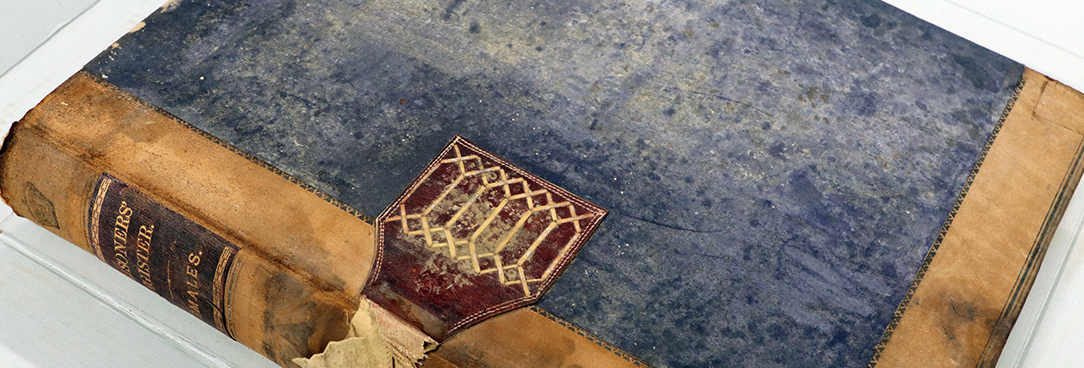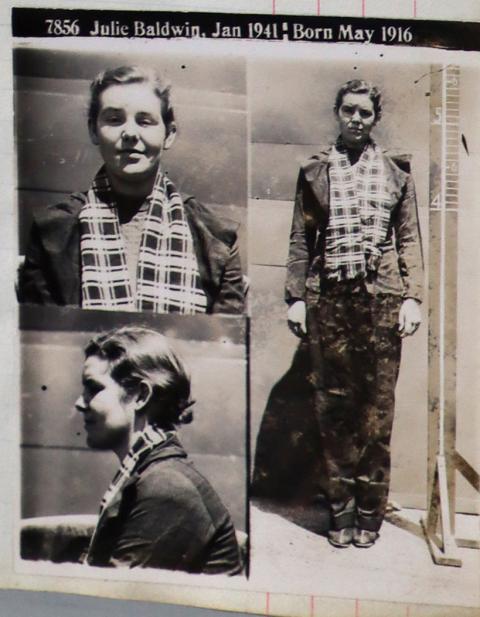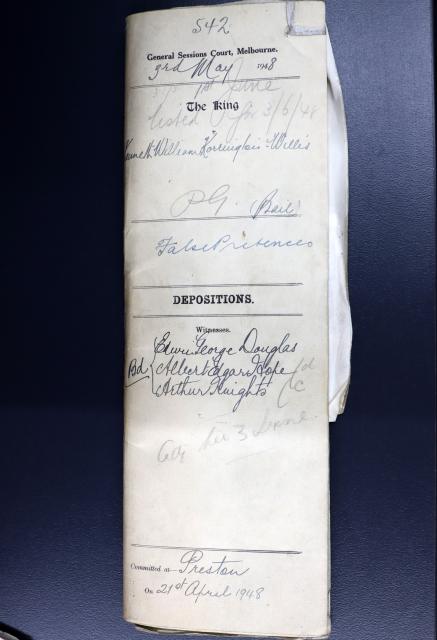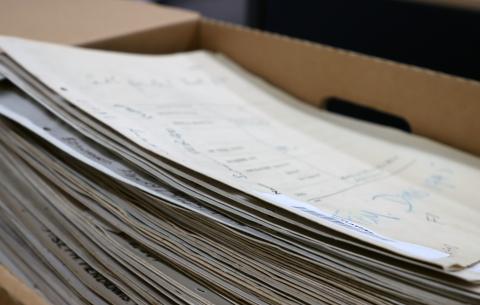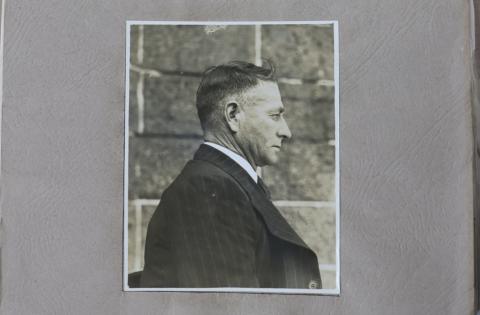
Author: Tara Oldfield
Senior Communications Advisor
Every year on the 1st of January, hundreds of state archival records are made public as part of Public Record Office Victoria’s annual Section 9 openings. Under Section 9 of the Public Records Act 1973, records of a private nature are closed to prevent the violation of personal privacy. A broad guide to time periods for closure under Section 9 is:
• Records primarily concerning adults may be closed for 75 years from the year they were created.
• Records concerning children as the primary subject may be closed for 99 years.
• Records such as staff records where the individuals concerned may still be in the workforce may be closed for a lesser period such as 30, 40, or 50 years as appropriate.
On the 1st of January 2024, files opened for the first time include prison records and mugshots of Victoria’s 1930s and 40s female criminals, and a 1948 criminal trial brief for notorious conman Kenneth William Korrington-Willis, alias Kid Stranger.
The Bonnie Doon Bandit
Among the pages of a large leather-bound book known as the Central Register of Female Prisoners, Julie Baldwin’s photo shows her in a checked scarf and dark blazer, hair in a low bun.
New Zealand-born Julie Baldwin was just 23-years-old and living in Sydney when she met Melbourne jockeys John and Leslie.
She had lost both parents 14 months prior and had travelled from New Zealand to Sydney and then onto Melbourne looking for work.
After meeting the jockeys and joining them in Melbourne, they stole a car from West Brunswick in and drove to Bonnie Doon where they, armed with a rifle, staged a hold up at the Post Office on the 25th of July 1939, getting away with £23 17/7 of the Postmaster General. A police car took chase with the bandits crashing into a bridge on the Benalla Road and rolling into a creek. They ran as far as they could into the bush but police on foot quickly captured the trio.
In court at Benalla, Julie told the Judge that she’d never been in trouble, nor visited Bonnie Doon before. The jockeys, it turned out, were brothers who grew up in the area, visiting the Post Office regularly to collect their mail. They moved to Melbourne to work as jockeys but injuries and bad luck had seen them quickly out of work. One of the brothers met Julie at a bar in Sydney and they all ended up in Melbourne together – coming up with the idea of a robbery as a way to make ends meet.
The men were sentenced to two years prison.
As for Julie?
She captured court and media attention for her choice of attire at trial.
According to the Benalla Standard, 18 August 1939:
“When the three accused appeared in the dock it was difficult at first to distinguish the girl, because her attire and short hair gave her a youthful appearance, and it was not until she answered to her name that many of the spectators realised that she was not a boy.”
Julie, too, received a two-year sentence.
The Sun, 28 August 1939:
“Wearing a man’s blue serge suit, Julie Helen Baldwin, 23, of Sydney, stood in the dock at the General Sessions today to receive a sentence of two years for robbery under arms. She had pleaded guilty to robbing Bonnie Doon Post Office on July 20 with two men companions, who already had been sentenced to two years, cumulative on a sentence for stealing the car and robbing the Post Office as her companions. “You say you are older than the men,” he continued. “The only difference I can see in your case is your sex, and you seem to have discarded even that to some extent. There was clear evidence of deliberate planning of this hold up and you went out of your way to get the gun which was used. Because of your sex, however, I feel I must differentiate between you and the others. Your sentence will therefore be concurrent with the sentence for stealing the car.”
Julie’s prison record shows that during her time at the Female Prison at Pentridge she was written up for igniting material in her cell, insolence to an officer, and disobeying orders. For each she received 24 hours solitary confinement. She was released from prison in June 1941.
The 1934 to 1948 female register containing Julie’s record is the last of its kind to be opened. It has been digitised and is available to view here. It's not yet indexed by name, so if you're looking for someone in particular you will need to trawl through each page. The final male register, spanning 1947 to 1948, is also open this year with the digitised version available here. After 1948, the justice system moved to a card-based recordkeeping system which remains closed.
Kid Stranger
A 1948 criminal trial brief for notorious conman Kenneth William Korrington-Willis is also being opened for the first time. Through the 1930s and 40s he posed as American boxer and showman Kid Stranger, scamming people out of money for fake investments. In Melbourne in 1944, he claimed to be a parachuter with a factory looking for investors. Many fell for his trick, handing over life savings, while 50,000 people attended Essendon Aerodrome to watch him jump out of a plane only to leave disappointed. He was sent to gaol, but his frauds continued after his release. In the 1948 brief opened today, he was convicted for defrauding Edwin George Douglas out of a £300 car deposit while posing as an American Captain in the Department of Justice.
Other records opened today include Ballarat Asylum Clinical Notes, 1920s Register of Patients Admitted to the Labour Ward of the Royal Women’s Hospital, the 1948 Capital Sentence File of Eric Stanley Jacobi, and Tramway Employee Record Cards.
Eric Stanley Jacobi
The capital sentence file of Eric Stanley Jacobi includes the secret report that saved the convicted murderer from the death penalty. Jacobi met a 19 year-old man named Norman Hurley through their work as tractor drivers. According to the file:
“Jacobi met Hurley at McKay’s, and though he never actually saw him with money, he was told by others that Hurley was a fool to carry a roll of notes and flash it about. A truck was being sold by ballot at McKay’s and Hurley asked Jacobi to put his name in as a dummy for Hurley so that he would have a second chance. Jacobi refused but said ‘I might put you on to a truck, Norm.’ Jacobi had no truck in mind, but Hurley persisted for several days, and Jacobi finally said ‘Meet me tonight at Snow’s about 7 o’clock.’ They met and went to the back of the racecourse where Jacobi said the caretaker had a truck. They waited about for twenty minutes, and then Hurley said ‘It’s a lonely place to meet anyone, Eric.’ Jacobi replied, ‘There’s no truck, Norman, I want your money.’ Hurley turned and grabbed Jacobi by the coat and said, ‘It will take a better bloody man than you to get it.’ Jacobi then struck Hurley three times with a small steel bar of shafting taken from work, and as Hurley fell to his knees, calling out, Jacobi took his wallet, threw the bar into the river, and ran away. On reaching the road he found the wallet contained £1-10-od only.”
“He didn’t know he’d killed him until her saw a newspaper poster at the football match some days later.”
The reason for his killing? He wanted to return home to his estranged wife and thought buying a brand new car would be the only way to impress her. According to newspaper reports at the time, the public was shocked when Jacobi's death sentence was commuted to life in prison. The Premier described a secret Medical Officer report that the court had not seen, that formed the basis for the decision to commute. This secret Medical report can be found in the capital sentence file.
See below for a full list of records opened 1 January 2024:
• Ararat Asylum Register of Complaints Against Staff, 1871-1948
• Ballarat Asylum Admission Register of Patients, 1936-1948
• Ballarat Asylum Clinical Case Notes and Patient Files, 1887-1948
• Ballarat Asylum Trial Leave Register, 1931-1948
• Ballarat Children’s Court Register, 1922-1924
• Ballarat Divorce Case Files, 1948
• Beechworth Outward Letter Books, 1945-1948
• Beechworth Patient Clinical Case Notes, 1902-1948
• Benalla Children’s Court Register, 1924
• Bound Circulated Photographs and Criminal Offences of Convicted Persons, 1945-1948
• Buln Buln Committee Minutes, 1989-1991
• Buln Buln Council Minutes, 1989-1993
• Capital Sentence Files, 1948
• Central Register of Female Prisoners, 1934-1948
• Central Register of Male Prisoners, 1947-1948
• Country Roads Board Minutes, 1973
• Country Roads Board Wages Records, 1947-1948
• Criminal Presentments and Final Orders, 1947-1948
• Criminal Record Books, 1940-1948
• Criminal Trial Briefs, 1948
• Criminal Trial Brief Register, 1948
• Crown Appointees Register – Data Input Sheets and Reports, 1986-1993
• Dental Practice Board Minutes and Papers, 1972-1973
• Divorce Case Files, 1948
• Divorce Cause Books, 1947-1948
• El Dorado Courts Children’s Court Register, 1908-1924
• Fairfield Infectious Diseases Admission and Discharge Register of Patients, 1923-1924
• Geelong West Children’s Court Register, 1916-1924
• Gordon Children’s Court Register, 1907-1924
• Index to Divorce Cause Books, 1948
• Inward Registered Correspondence for the Attorney-General’s Department, 1947-1948
• Janefield Staff Register, 1937-1973
• Kew Asylum Post Mortem Register, 1946-1948
• Kew Cottages Medical Journals, 1920-1924
• Kew Mental Hospital Head Attendant’s Daily Report Books – Male Department, 1947-1948
• Kew Mental Hospital Head Nurse’s Daily Report Book – Female Wards, 1947-1948
• Kew Mental Hospital Patient Clinical Notes, 1946-1948
• Kyabram Children’s Court Register, 1907-1924
• Melbourne Court of Petty Sessions Index to Melbourne Cases, 1911-1924
• Melbourne Water Historical Records Collection, 1946-1948
• Mont Park Mental Hospital Head Nurse’s Daily Report Books – Female Department, 1947-1948
• Pentridge Register of Prisoners Received and Discharged “J” Division, 1937-1948
• Pharmacy Board Minute Books, 1972-1973
• Registers of Voluntary Boarders in Hospitals for the Insane, 1948
• Roads Corporation Secretary’s Letter Books, 1947-1948
• Royal Children’s Hospital In-Patient Admission and Discharge Register, 1922-1924
• Royal Children’s Hospital In-Patient Death Registers, 1986-1993
• Royal Melbourne Hospital Secretary’s and Manager’s Subject Correspondence Files, 1969-1973
• Royal Park Psychiatric Hospital Admission and Discharge Register of Patients: Recommended Patients, 1942-1948
• Royal Park Psychiatric Hospital Admission and Discharge Register of Patients: Voluntary Boarders, 1942-1948
• Royal Park Psychiatric Hospital Discharge Register of Patients, 1938-1948
• Royal Park Psychiatric Hospital Discharge Register of Patients, 1946-1948
• Royal Park Psychiatric Hospital Post Mortem Register, 1947-1948
• Royal Women’s Hospital Register of Patients Admitted to Labour Ward Midwifery Department, 1920-1924
• Royal Women’s Hospital Extern Case Book, 1923-1924
• Sebastopol Children’s Court Register, 1907-1924
• Sunbury Mental Hospital Admission Warrants – Male Patients, 1946-1948
• Sunbury Mental Hospital Nursing Report Books – Female, 1947-1948
• Sunbury Mental Hospital Restraint and Seclusion Register, 1948
• Sunnyside Licenced House Asylum Records, 1938-1948
• Supreme Court Presentments, 1948
• Swinburne Technical College Examination Results, 1947-1948
• Swinburne Technical College Examination Results Master List, 1936-1948
• Teacher Examination Entry Forms, 1959-1973
• Tramway Employees Records Cards, 1967-1968
• Victorian Railways Accident Compensation Claim Book, 1966-1968
• Victorian Railways Accident Compensation Claim Register, 1967-1968
• Ward Registers, 1923-1924
Material in the Public Record Office Victoria archival collection contains words and descriptions that reflect attitudes and government policies at different times which may be insensitive and upsetting
Aboriginal and Torres Strait Islander Peoples should be aware the collection and website may contain images, voices and names of deceased persons.
PROV provides advice to researchers wishing to access, publish or re-use records about Aboriginal Peoples
